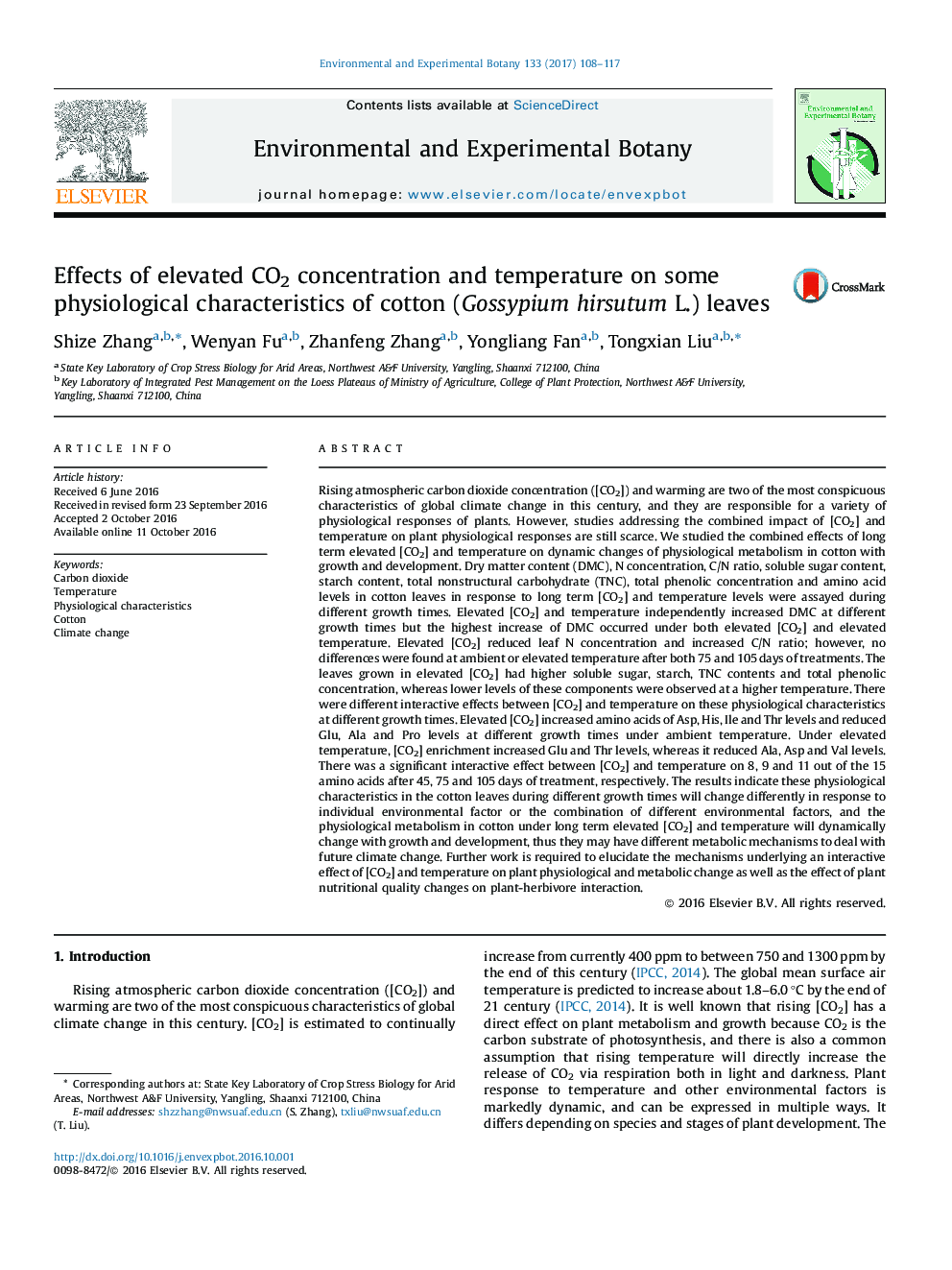| کد مقاله | کد نشریه | سال انتشار | مقاله انگلیسی | نسخه تمام متن |
|---|---|---|---|---|
| 6388823 | 1628044 | 2017 | 10 صفحه PDF | دانلود رایگان |

- Physiological metabolism of cotton changed dynamically and responded differently to long term elevated [CO2] (EC) and temperature (ET) during different growth times.
- DMC and C/N ratio were markedly increased by the combination of ETEC, but leaf N was reduced by ETEC.
- EC enhanced sugar, starch, TNC, total phenolic contents but they were significantly decreased by ETEC.
- Specific amino acid content changed differently in response to [CO2] and temperature.
- There were differently interactive effects between [CO2] and temperature during different growth times.
Rising atmospheric carbon dioxide concentration ([CO2]) and warming are two of the most conspicuous characteristics of global climate change in this century, and they are responsible for a variety of physiological responses of plants. However, studies addressing the combined impact of [CO2] and temperature on plant physiological responses are still scarce. We studied the combined effects of long term elevated [CO2] and temperature on dynamic changes of physiological metabolism in cotton with growth and development. Dry matter content (DMC), N concentration, C/N ratio, soluble sugar content, starch content, total nonstructural carbohydrate (TNC), total phenolic concentration and amino acid levels in cotton leaves in response to long term [CO2] and temperature levels were assayed during different growth times. Elevated [CO2] and temperature independently increased DMC at different growth times but the highest increase of DMC occurred under both elevated [CO2] and elevated temperature. Elevated [CO2] reduced leaf N concentration and increased C/N ratio; however, no differences were found at ambient or elevated temperature after both 75 and 105Â days of treatments. The leaves grown in elevated [CO2] had higher soluble sugar, starch, TNC contents and total phenolic concentration, whereas lower levels of these components were observed at a higher temperature. There were different interactive effects between [CO2] and temperature on these physiological characteristics at different growth times. Elevated [CO2] increased amino acids of Asp, His, Ile and Thr levels and reduced Glu, Ala and Pro levels at different growth times under ambient temperature. Under elevated temperature, [CO2] enrichment increased Glu and Thr levels, whereas it reduced Ala, Asp and Val levels. There was a significant interactive effect between [CO2] and temperature on 8, 9 and 11 out of the 15 amino acids after 45, 75 and 105Â days of treatment, respectively. The results indicate these physiological characteristics in the cotton leaves during different growth times will change differently in response to individual environmental factor or the combination of different environmental factors, and the physiological metabolism in cotton under long term elevated [CO2] and temperature will dynamically change with growth and development, thus they may have different metabolic mechanisms to deal with future climate change. Further work is required to elucidate the mechanisms underlying an interactive effect of [CO2] and temperature on plant physiological and metabolic change as well as the effect of plant nutritional quality changes on plant-herbivore interaction.
Journal: Environmental and Experimental Botany - Volume 133, January 2017, Pages 108-117